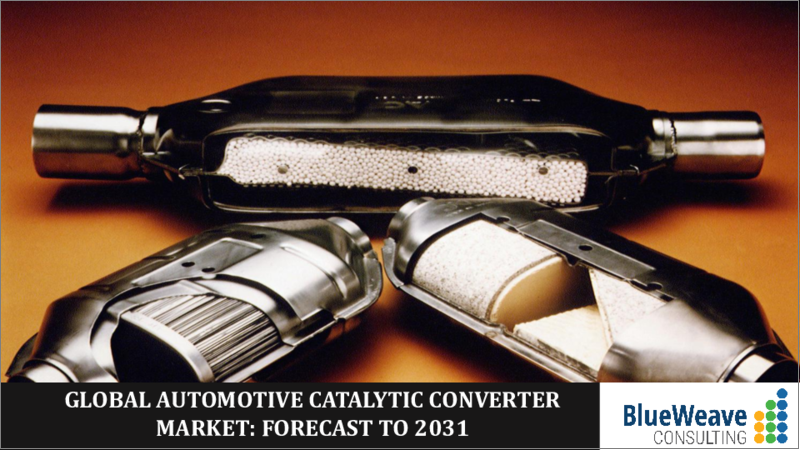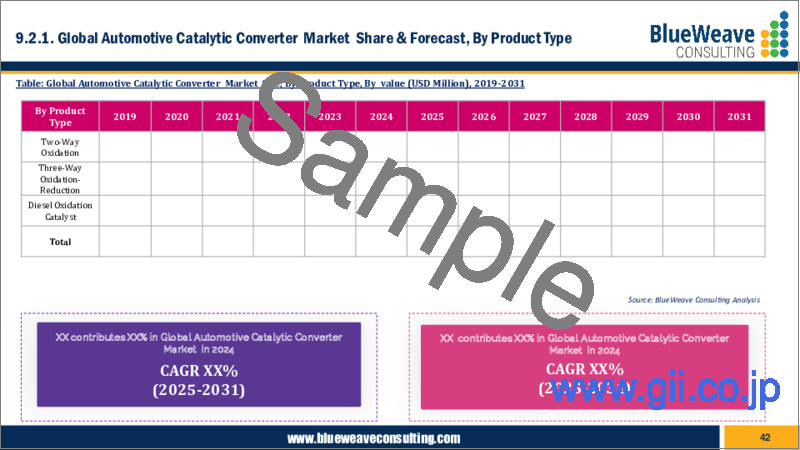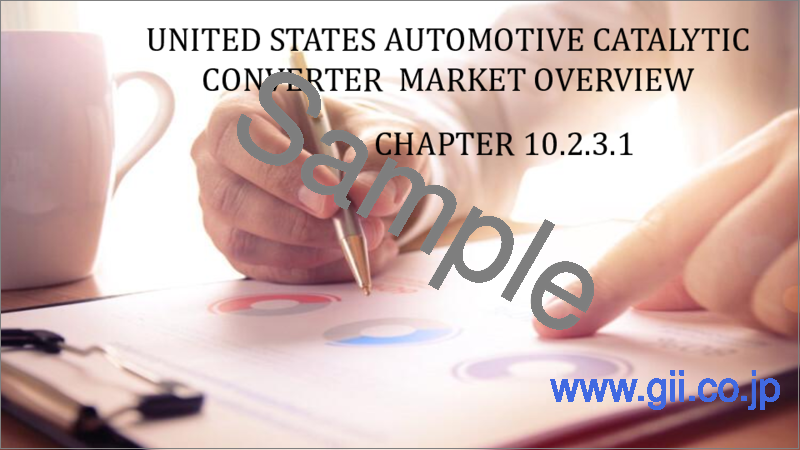|
|
市場調査レポート
商品コード
1615197
自動車用触媒コンバーターの世界市場:製品別、材料別、地域別、動向分析、競合情勢、予測、2019~2030年Automotive Catalytic Converter Market, By Product; By Material; By Region (North America, Europe, Asia Pacific, Latin America, Middle East and Africa ), Global Trend Analysis, Competitive Landscape & Forecast, 2019-2030 |
||||||
|
|||||||
| 自動車用触媒コンバーターの世界市場:製品別、材料別、地域別、動向分析、競合情勢、予測、2019~2030年 |
|
出版日: 2024年12月12日
発行: Blueweave Consulting
ページ情報: 英文 495 Pages
納期: 2~3営業日
|
全表示
- 概要
- 目次
自動車用触媒コンバーターの世界市場は2030年までに250億米ドルに達する見込み
自動車用触媒コンバーターの世界市場は、環境問題への関心の高まりと自動車の生産台数の増加により活況を呈しています。
戦略コンサルティングと市場調査の大手企業であるBlueWeave Consulting社は、最近の調査で、2023年の自動車用触媒コンバーターの世界市場規模を148億米ドルと推定しました。2024年から2030年までの予測期間において、BlueWeaveは自動車用触媒コンバーターの世界市場規模がCAGR 7.60%で拡大し、2030年には246億米ドルに達すると予測しています。自動車用触媒コンバーターの世界市場の主な成長要因には、炭化水素、一酸化炭素、窒素酸化物など、自動車の排気ガスから排出される有害物質の量の増加や、排出ガスを最小限に抑えるための政府の厳しい要求が含まれます。また、自動車用触媒コンバーターの世界市場の拡大は、予測期間中に各地域で乗用車と商用車の需要が増加した結果、自動車生産が拡大することによって牽引されると予想されます。
機会- 排出ガス削減のための厳しい政府規制
自動車からの排出ガスは、世界中で大気汚染の主な原因の一つとなっています。自動車はガソリンやディーゼルの燃焼により、一酸化炭素、窒素酸化物、二酸化硫黄などの有害汚染物質を大気中に放出します。そのため、自動車メーカーは排気ガスを制御するために様々な方法を採用していますが、その中でも触媒コンバーターは業界で最も一般的に使用されている方法です。ScienceDirectによると、触媒コンバーターは燃焼を最適化し、排気温度を適度に低く保つことで使用する空燃比の効率を向上させます。さらに、増加する燃料排出を制限するための厳しい政府規制が、自動車用触媒コンバーターの需要を押し上げ、世界市場の成長を促進すると予想されています。
地政学的緊張の高まりが自動車用触媒コンバーターの世界市場に与える影響
地政学的緊張の激化は、自動車用触媒コンバーターの世界市場の成長に大きな課題をもたらす可能性があります。触媒コンバーターは、ロジウム、パラジウム、プラチナなどの貴金属を使用して製造されます。サプライ・チェーンの混乱、入手可能性の制限、ロシアのような金属が豊富な地域における地政学的緊張、これらの国々に対する制裁措置の結果として、価格が上昇する可能性があります。国際市場における貴金属価格の上昇は、触媒コンバーターの製造コストを引き上げ、自動車のコストを押し上げる可能性があります。さらに、地政学的紛争や緊張に起因する経済の不確実性や景気減速は、特に新興国における消費者の自動車需要を低下させ、触媒コンバーターの需要も低下させる可能性があります。
プラチナ・セグメントが最も速いCAGRで成長する
自動車用触媒コンバーターの世界市場では、プラチナ・セグメントが最大のシェアを占めています。プラチナが重要な触媒成分として広く使用されている主な理由は、有害排出ガスを削減するために必要な化学プロセスにおけるプラチナの有効性と安定性です。しかし、プラチナは高価であり、窒素酸化物を変換する活性が低いため、業界ではプラチナからパラジウムやロジウムへのシフトが顕著になっています。パラジウムは熱安定性が高く、同種のものよりも安価であるため、市場成長の原動力となっています。ロジウムは窒素酸化物を除去する活性が最大であるため、市場シェアも大きいです。
アジア太平洋地域が自動車用触媒コンバーターの世界市場をリード
アジア太平洋地域が自動車用触媒コンバーターの世界市場を独占しています。この地域の自動車生産は中国、インド、日本に集中しており、急速な都市化と消費者の可処分所得の増加によって自動車需要が伸びていることが、自動車用触媒コンバーターの需要を牽引しています。2023年には、中国だけで乗用車と商用車の両方を含む約3,000万台の自動車が生産されています。自動車用触媒コンバーターの市場も、大気汚染と地球温暖化を削減するためにアジア太平洋諸国の政府が実施している厳しい自動車排ガス規制の結果、拡大しています。
競合情勢
自動車用触媒コンバーターの世界市場の主要な業界プレーヤーには、Johnson Matthey、BASF、Tenneco、Faurecia、Continental、Eberspacher、Umicore、Yutaka Giken、Magneti Marelli、Dana Incorporated、BorgWarner、Wabco Holdingsなどが含まれます。多数の企業が存在することで、大きな市場シェアを獲得しようと競争し、市場競争が激化しています。
これらの企業は、M&A、パートナーシップ、合弁事業、ライセンス契約、新製品発売など、さまざまな戦略を採用し、市場シェアをさらに高めています。
本レポートの詳細な分析により、成長の可能性、今後の動向、世界の自動車用触媒コンバーター市場に関する情報を提供します。また、総市場規模の予測を促進する要因にも焦点を当てています。当レポートは、世界の自動車用触媒コンバーター市場の最新技術動向や、意思決定者が戦略的な意思決定を行う際に役立つ業界インサイトを提供することをお約束します。さらに、市場の成長促進要因・課題・競争力についても分析しています。
目次
第1章 調査の枠組み
第2章 エグゼクティブサマリー
第3章 世界の自動車用触媒コンバーター市場の洞察
- 業界バリューチェーン分析
- DROC分析
- 成長促進要因
- 環境問題への懸念の高まり
- 自動車生産の増加
- 燃費の良い自動車への需要の高まり
- 抑制要因
- 電気自動車(EV)の普及増加
- 貴金属の高価格
- 機会
- 新興市場
- テクノロジーの進歩
- 課題
- 盗難と闇市場活動
- 老朽化した車両群
- 成長促進要因
- 技術の進歩/最近の動向
- 規制の枠組み
- ポーターのファイブフォース分析
第4章 世界の自動車用触媒コンバーター市場のマーケティング戦略
第5章 世界の自動車用触媒コンバーター市場概要
- 市場規模と予測、2019-2030年
- 金額別
- 市場シェアと予測
- 製品別
- 双方向酸化
- 三酸化還元
- ディーゼル酸化触媒
- 材料別
- プラチナ
- パラジウム
- ロジウム
- 地域別
- 北米
- 欧州
- アジア太平洋(APAC)
- ラテンアメリカ(LATAM)
- 中東およびアフリカ(MEA)
- 製品別
第6章 北米の自動車用触媒コンバーター市場
- 市場規模と予測、2019-2030年
- 金額別
- 市場シェアと予測
- 製品別
- 材料別
- 国別
- 米国
- カナダ
第7章 欧州の自動車用触媒コンバーター市場
- 市場規模と予測、2019-2030年
- 金額別
- 市場シェアと予測
- 製品別
- 材料別
- 国別
- ドイツ
- 英国
- イタリア
- フランス
- スペイン
- ベルギー
- ロシア
- オランダ
- その他欧州
第8章 アジア太平洋地域の自動車用触媒コンバーター市場
- 市場規模と予測、2019-2030年
- 金額別
- 市場シェアと予測
- 製品別
- 材料別
- 国別
- 中国
- インド
- 日本
- 韓国
- オーストラリアとニュージーランド
- インドネシア
- マレーシア
- シンガポール
- ベトナム
- アジア太平洋地域のその他諸国
第9章 ラテンアメリカの自動車用触媒コンバーター市場
- 市場規模と予測、2019-2030年
- 金額別
- 市場シェアと予測
- 製品別
- 材料別
- 国別
- ブラジル
- メキシコ
- アルゼンチン
- ペルー
- その他のラテンアメリカ
第10章 中東およびアフリカの自動車用触媒コンバーター市場
- 市場規模と予測、2019-2030年
- 金額別
- 市場シェアと予測
- 製品別
- 材料別
- 国別
- サウジアラビア
- アラブ首長国連邦
- カタール
- クウェート
- 南アフリカ
- ナイジェリア
- アルジェリア
- その他中東・アフリカ
第11章 競合情勢
- 主要プレーヤーとその提供内容のリスト
- 世界の自動車用触媒コンバーター企業の市場シェア分析、2023年
- 経営パラメータによる競合ベンチマーキング
- 主要な戦略的展開(合併、買収、提携)
第12章 高まる地政学的緊張が世界の自動車用触媒コンバーター市場に与える影響
第13章 企業プロファイル(会社概要、財務マトリックス、競合情勢、主要人物、主要競合、連絡先、戦略展望、 SWOT分析)
- Johnson Matthey
- BASF
- Tenneco
- Faurecia
- Continental
- Eberspacher
- Umicore
- Yutaka Giken
- Magneti Marelli
- Dana Incorporated
- BorgWarner
- Wabco Holdings
- その他の主要企業
第14章 主要な戦略的提言
第15章 調査手法
Global Automotive Catalytic Converter Market Poised to Touch USD 25 Billion by 2030
Global Automotive Catalytic Converter Market is flourishing because of the rising environmental concerns and increasing production of vehicles.
BlueWeave Consulting, a leading strategic consulting and market research firm, in its recent study, estimated Global Automotive Catalytic Converter Market size at USD 14.8 billion in 2023. During the forecast period between 2024 and 2030, BlueWeave expects Global Automotive Catalytic Converter Market size to expand at a CAGR of 7.60% reaching a value of USD 24.6 billion by 2030. Major growth factors for Global Automotive Catalytic Converter Market include growing quantities of hazardous substances from vehicle exhaust, including as hydrocarbons, carbon monoxide, and nitrogen oxides and stringent government requirements to minimize emissions. The expansion of Global Automotive Catalytic Converter Market is also expected to be driven by expanding vehicle production as a result of rising demand for passenger and commercial vehicles across the regions over the projected period.
Opportunity - Stringent Government Regulations to Reduce Emissions
Emissions from vehicles are one of the major causes of air pollution worldwide. Vehicles release toxic pollutants, such as carbon monoxide, nitrogen oxides, and sulfur dioxides, into the air because of gasoline and diesel combustion. Therefore, automotive manufacturers are adopting various methods to control exhaust emissions, among which the catalytic converter is the most commonly used method in the industry. According to ScienceDirect, catalytic converters optimize combustion and provide better efficiency for air-fuel ratios used by keeping exhaust temperature moderately low. Furthermore, stringent government regulations to limit the increasing fuel emissions are anticipated to boost the demand for automotive catalytic converters, driving its global market growth.
Impact of Escalating Geopolitical Tensions on Global Automotive Catalytic Converter Market
Intensifying geopolitical tensions may pose significant challenges for the growth of Global Automotive Catalytic Converter Market. Catalytic converters are made using precious metals such as rhodium, palladium, and platinum. Prices may rise as a result of supply chain disruptions, limited availability, and geopolitical tensions in metal-rich regions like Russia and sanctions placed on these nations. The increase in the price of precious metals on the international market may raise the cost of producing catalytic converters, which could drive up the cost of automobiles as well. Furthermore, economic uncertainties and slowdowns caused by geopolitical conflicts and tensions may lower consumer demand for automobiles, particularly in emerging nations, which would lower demand for catalytic converters as well.
Platinum Segment to Grow at Fastest CAGR
The platinum segment holds the largest share of Global Automotive Catalytic Converter Market. Platinum's effectiveness and stability in the chemical processes needed to reduce hazardous emissions are the primary reasons for its widespread usage as a significant catalyst component. However, because platinum is expensive and has less activity in converting nitrogen oxides, the industry is seeing a significant shift away from platinum and toward palladium and rhodium. Palladium has high thermal stability and is less expensive than its counterparts, which drives its market growth. As rhodium has the maximum activity in eliminating nitrogen oxides, it also holds a significant market share.
Asia Pacific Leads Global Automotive Catalytic Converter Market
Asia Pacific dominates Global Automotive Catalytic Converter Market. Demand for automotive catalytic converters is driven by the region's high concentration of automobile production in China, India, and Japan, as well as the growing demand for automobiles spurred by rapid urbanization and rising consumer disposable income. In 2023, China alone manufactured almost 30 million automobiles, including both passenger and commercial models. The market for automotive catalytic converters is also expanding as a result of stringent vehicle emission regulations being implemented by governments in Asia Pacific nations in an effort to reduce air pollution and global warming.
Competitive Landscape
The major industry players of Global Automotive Catalytic Converter Market include Johnson Matthey, BASF, Tenneco, Faurecia, Continental, Eberspacher, Umicore, Yutaka Giken, Magneti Marelli, Dana Incorporated, BorgWarner, and Wabco Holdings. The presence of high number of companies intensify the market competition as they compete to gain a significant market share.
These companies employ various strategies, including mergers and acquisitions, partnerships, joint ventures, license agreements, and new product launches to further enhance their market share.
The in-depth analysis of the report provides information about growth potential, upcoming trends, and Global Automotive Catalytic Converter Market. It also highlights the factors driving forecasts of total market size. The report promises to provide recent technology trends in Global Automotive Catalytic Converter Market and industry insights to help decision-makers make sound strategic decisions. Furthermore, the report also analyzes the growth drivers, challenges, and competitive dynamics of the market.
Table of Contents
1. Research Framework
- 1.1. Research Objective
- 1.2. Product Overview
- 1.3. Market Segmentation
2. Executive Summary
3. Global Automotive Catalytic Converter Market Insights
- 3.1. Industry Value Chain Analysis
- 3.2. DROC Analysis
- 3.2.1. Growth Drivers
- 3.2.1.1. Rising Environmental Concerns
- 3.2.1.2. Increasing Vehicle Production
- 3.2.1.3. Growing Demand for Fuel-Efficient Vehicles
- 3.2.2. Restraints
- 3.2.2.1. Rising Adoption of Electric Vehicles (EVs)
- 3.2.2.2. High Cost of Precious Metals
- 3.2.3. Opportunities
- 3.2.3.1. Emerging Markets
- 3.2.3.2. Advancement in Technology
- 3.2.4. Challenges
- 3.2.4.1. Theft and Black Market Activity
- 3.2.4.2. Aging Vehicle Fleet
- 3.2.1. Growth Drivers
- 3.3. Technological Advancements/Recent Developments
- 3.4. Regulatory Framework
- 3.5. Porter's Five Forces Analysis
- 3.5.1. Bargaining Power of Suppliers
- 3.5.2. Bargaining Power of Buyers
- 3.5.3. Threat of New Entrants
- 3.5.4. Threat of Substitutes
- 3.5.5. Intensity of Rivalry
4. Global Automotive Catalytic Converter Market Marketing Strategies
5. Global Automotive Catalytic Converter Market Overview
- 5.1. Market Size & Forecast, 2019-2030
- 5.1.1. By Value (USD Billion)
- 5.2. Market Share & Forecast
- 5.2.1. By Product
- 5.2.1.1. Two-Way Oxidation
- 5.2.1.2. Three-Way Oxidation-Reduction
- 5.2.1.3. Diesel Oxidation Catalyst
- 5.2.2. By Material
- 5.2.2.1. Platinum
- 5.2.2.2. Palladium
- 5.2.2.3. Rhodium
- 5.2.3. By Region
- 5.2.3.1. North America
- 5.2.3.2. Europe
- 5.2.3.3. Asia Pacific (APAC)
- 5.2.3.4. Latin America (LATAM)
- 5.2.3.5. Middle East and Africa (MEA)
- 5.2.1. By Product
6. North America Automotive Catalytic Converter Market
- 6.1. Market Size & Forecast, 2019-2030
- 6.1.1. By Value (USD Billion)
- 6.2. Market Share & Forecast
- 6.2.1. By Product
- 6.2.2. By Material
- 6.2.3. By Country
- 6.2.3.1. United States
- 6.2.3.1.1. By Product
- 6.2.3.1.2. By Material
- 6.2.3.2. Canada
- 6.2.3.2.1. By Product
- 6.2.3.2.2. By Material
7. Europe Automotive Catalytic Converter Market
- 7.1. Market Size & Forecast, 2019-2030
- 7.1.1. By Value (USD Billion)
- 7.2. Market Share & Forecast
- 7.2.1. By Product
- 7.2.2. By Material
- 7.2.3. By Country
- 7.2.3.1. Germany
- 7.2.3.1.1. By Product
- 7.2.3.1.2. By Material
- 7.2.3.2. United Kingdom
- 7.2.3.2.1. By Product
- 7.2.3.2.2. By Material
- 7.2.3.3. Italy
- 7.2.3.3.1. By Product
- 7.2.3.3.2. By Material
- 7.2.3.4. France
- 7.2.3.4.1. By Product
- 7.2.3.4.2. By Material
- 7.2.3.5. Spain
- 7.2.3.5.1. By Product
- 7.2.3.5.2. By Material
- 7.2.3.6. Belgium
- 7.2.3.6.1. By Product
- 7.2.3.6.2. By Material
- 7.2.3.7. Russia
- 7.2.3.7.1. By Product
- 7.2.3.7.2. By Material
- 7.2.3.8. The Netherlands
- 7.2.3.8.1. By Product
- 7.2.3.8.2. By Material
- 7.2.3.9. Rest of Europe
- 7.2.3.9.1. By Product
- 7.2.3.9.2. By Material
8. Asia Pacific Automotive Catalytic Converter Market
- 8.1. Market Size & Forecast, 2019-2030
- 8.1.1. By Value (USD Billion)
- 8.2. Market Share & Forecast
- 8.2.1. By Product
- 8.2.2. By Material
- 8.2.3. By Country
- 8.2.3.1. China
- 8.2.3.1.1. By Product
- 8.2.3.1.2. By Material
- 8.2.3.2. India
- 8.2.3.2.1. By Product
- 8.2.3.2.2. By Material
- 8.2.3.3. Japan
- 8.2.3.3.1. By Product
- 8.2.3.3.2. By Material
- 8.2.3.4. South Korea
- 8.2.3.4.1. By Product
- 8.2.3.4.2. By Material
- 8.2.3.5. Australia & New Zealand
- 8.2.3.5.1. By Product
- 8.2.3.5.2. By Material
- 8.2.3.6. Indonesia
- 8.2.3.6.1. By Product
- 8.2.3.6.2. By Material
- 8.2.3.7. Malaysia
- 8.2.3.7.1. By Product
- 8.2.3.7.2. By Material
- 8.2.3.8. Singapore
- 8.2.3.8.1. By Product
- 8.2.3.8.2. By Material
- 8.2.3.9. Vietnam
- 8.2.3.9.1. By Product
- 8.2.3.9.2. By Material
- 8.2.3.10. Rest of APAC
- 8.2.3.10.1. By Product
- 8.2.3.10.2. By Material
9. Latin America Automotive Catalytic Converter Market
- 9.1. Market Size & Forecast, 2019-2030
- 9.1.1. By Value (USD Billion)
- 9.2. Market Share & Forecast
- 9.2.1. By Product
- 9.2.2. By Material
- 9.2.3. By Country
- 9.2.3.1. Brazil
- 9.2.3.1.1. By Product
- 9.2.3.1.2. By Material
- 9.2.3.2. Mexico
- 9.2.3.2.1. By Product
- 9.2.3.2.2. By Material
- 9.2.3.3. Argentina
- 9.2.3.3.1. By Product
- 9.2.3.3.2. By Material
- 9.2.3.4. Peru
- 9.2.3.4.1. By Product
- 9.2.3.4.2. By Material
- 9.2.3.5. Rest of LATAM
- 9.2.3.5.1. By Product
- 9.2.3.5.2. By Material
10. Middle East & Africa Automotive Catalytic Converter Market
- 10.1. Market Size & Forecast, 2019-2030
- 10.1.1. By Value (USD Billion)
- 10.2. Market Share & Forecast
- 10.2.1. By Product
- 10.2.2. By Material
- 10.2.3. By Country
- 10.2.3.1. Saudi Arabia
- 10.2.3.1.1. By Product
- 10.2.3.1.2. By Material
- 10.2.3.2. UAE
- 10.2.3.2.1. By Product
- 10.2.3.2.2. By Material
- 10.2.3.3. Qatar
- 10.2.3.3.1. By Product
- 10.2.3.3.2. By Material
- 10.2.3.4. Kuwait
- 10.2.3.4.1. By Product
- 10.2.3.4.2. By Material
- 10.2.3.5. South Africa
- 10.2.3.5.1. By Product
- 10.2.3.5.2. By Material
- 10.2.3.6. Nigeria
- 10.2.3.6.1. By Product
- 10.2.3.6.2. By Material
- 10.2.3.7. Algeria
- 10.2.3.7.1. By Product
- 10.2.3.7.2. By Material
- 10.2.3.8. Rest of MEA
- 10.2.3.8.1. By Product
- 10.2.3.8.2. By Material
11. Competitive Landscape
- 11.1. List of Key Players and Their Offerings
- 11.2. Global Automotive Catalytic Converter Company Market Share Analysis, 2023
- 11.3. Competitive Benchmarking, By Operating Parameters
- 11.4. Key Strategic Developments (Mergers, Acquisitions, Partnerships)
12. Impact of Escalating Geopolitical Tensions on Global Automotive Catalytic Converter Market
13. Company Profiles (Company Overview, Financial Matrix, Competitive Landscape, Key Personnel, Key Competitors, Contact Address, Strategic Outlook, and SWOT Analysis)
- 13.1. Johnson Matthey
- 13.2. BASF
- 13.3. Tenneco
- 13.4. Faurecia
- 13.5. Continental
- 13.6. Eberspacher
- 13.7. Umicore
- 13.8. Yutaka Giken
- 13.9. Magneti Marelli
- 13.10. Dana Incorporated
- 13.11. BorgWarner
- 13.12. Wabco Holdings
- 13.13. Other Prominent Players
14. Key Strategic Recommendations
15. Research Methodology
- 15.1. Qualitative Research
- 15.1.1. Primary & Secondary Research
- 15.2. Quantitative Research
- 15.3. Market Breakdown & Data Triangulation
- 15.3.1. Secondary Research
- 15.3.2. Primary Research
- 15.4. Breakdown of Primary Research Respondents, By Region
- 15.5. Assumptions & Limitations
*Financial information of non-listed companies can be provided as per availability.
**The segmentation and the companies are subject to modifications based on in-depth secondary research for the final deliverable.






